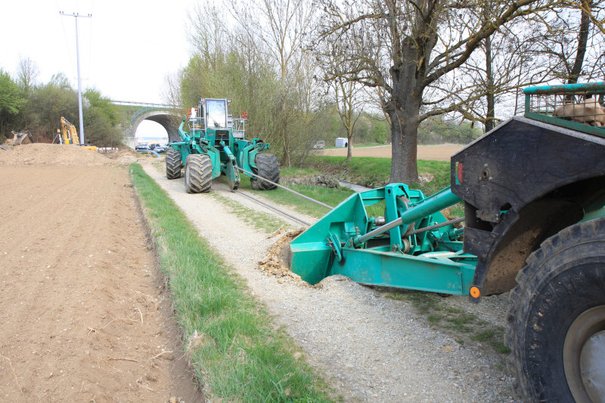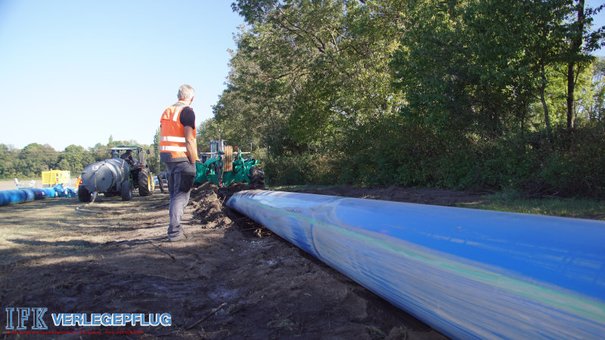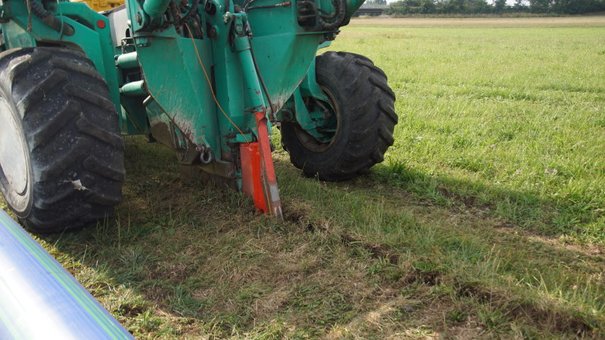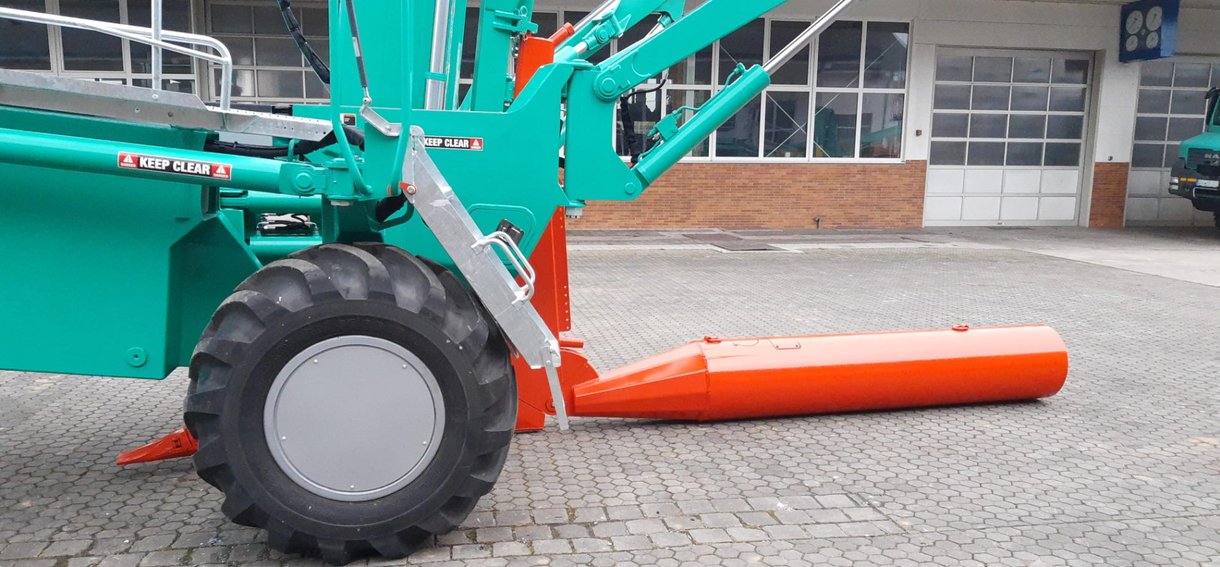Torpedo ploughing method from FOECK - for highly efficient and environmentally friendly pipe laying
With the special torpedo plough method, even non-flexible pipes such as steel pipes or ductile iron pipes can be pulled into the ground without digging. This method differs from the more familiar procedure developed for flexible pipes, which uses a laying shaft. In this case, the pipe is not laid continuously into the ground from above via the laying shaft, but is pulled in afterwards, which is why it is also called the pulling-in method. The torpedo-shaped displacer guided in the ground couples the beginning of the laid pipe string. The plough is pulled with the strongest mobile winch in the world, which places the torpedo with the pipe in it at the desired depth.
The highest possible tensile load of the respective pipes are to be determined in advance. This value is entered into our measuring system so that the permissible total tensile force is not exceeded. Moreover, with our system, any frictional resistance that occurs can be reduced by means of a refillable sliding fluid on the torpedo's hitch. The acting tensile forces are continuously monitored and recorded, and when the maximum permissible values are reached, the process is stopped immediately. In addition, it is of course also possible to document and check the laying depth and position.
With the torpedo plough method, precise pipe laying is possible in soils that are difficult to loosen, as well as in waterlogged ground and on slopes. With FOECK machines you can lay up to 1500 metres a day and save considerable resources, as the laying speed is up to 5 times faster than with conventional methods.
Overview of the FOECK torpedo ploughing method: Key data and properties
- The large nominal torpedo diameter allows pipe diameters of up to 630 millimetres. -
- The mobile winches develop enormous tractive forces of up to 180 tonnes, controlled and limit-regulated.
- Laying depths of up to 2.5 metres can be easily and safely achieved, depending on the soil conditions. A frost depth of at least 1.2 metres for water-bearing pipes or 80 to 140 centimetres for gas pipes are therefore no particular challenge for the system.
- The FOECK technology is particularly manoeuvrable, suitable for gradients and adaptable to profiled terrain and changing subsoils, not least thanks to its hydraulically adjustable elements such as wheel booms, sword shoes etc. - The laying system can cope with practically all soils up to soil class 5: loose rock, clay, sand, swamp, boulders, water.
- The machines can lay up to 1500 metres of pipeline per day, depending on the type and diameter of the pipeline, the soil conditions and the preparation.
- Even close to obstacles, whether below or on the surface, our installation technique comes confidently and safely and even allows for shorter distances than invasive excavation methods.
- We provide comprehensive, detailed and technically correct advice and training. To this end, we are available to machine operators and project managers for the preparation and execution of each individual project. Your success is also ours.
In short: Our machines lay precisely and unimpressed in conditions where others fail.
References: an excerpt of successfully completed installation projects
- DA 560 drinking water pipeline in Höchstenbühel
- DN 400 steel pipeline in Schweinfurt
- DA 350 drinking water pipeline in Gifhorn



![[Translate to Englisch:] Walter Föckersperger](/fileadmin/media/home/Walter-Foeckersperger.jpg)
We are pleased to advise you
Would you like to learn more about the FOECK laying system? Then we look forward to hearing from you by phone, e-mail or via our contact form. You are also welcome to arrange a consultation with us in which we present technical details of our products.
Walter Föckersperger, Managing Director
Phone: +49(0) 8742 43897-0
Mail: walter.foeckersperger@foeck.com
Advantages and benefits of the torpedo method from FOECK: Protect the environment, budget and time account
In principle, ploughing procedures involve only minimal intervention in the surface and soil. Even just driving over the route once means significant relief. This is another reason why the method is suitable for measures within protected areas. Apart from the start, connection and end pits, the pipe-pulling technique does not require any costly civil engineering work, especially not along the laying route.
The soil structure remains almost untouched, there is hardly any compaction and the actual laying is much faster.
The FOECK torpedo ploughing method completes the laying of the pipes in one fifth of the usual time for trench excavation, backfilling and levelling using conventional methods. The difference: with FOECK's torpedo ploughing method, laying work means a short-term construction site. With just as good a result quality and without the necessary personnel and technical expenditure for milling, drilling or excavating. The FOECK laying system even saves fuel and carbon dioxide: only around 350 litres of diesel fuel for 1500 metres of laid pipeline.
The use of FOECK machines pays off both economically and ecologically.
In use worldwide for trenchless pipe-laying for over 60 years
Walter Föckersperger GmbH has made an international name for itself as a special developer and manufacturer of ploughing methods for laying cables and pipes. Our family business in Pauluszell near Landshut in Bavaria can look back on more than 60 years of experience. We continue to draw on this experience potential for innovative further developments. To date, more than 450,000 kilometres of cables and pipes have been laid worldwide with our systems.
You too can benefit from our know-how and let us advise you on the torpedo ploughing method. Arrange a personal appointment with us now.
We will accompany your project from the beginning to completion.
FAQ
What is a torpedo ploughing method and when is it used?
The torpedo plough method is a special method for trenchless underground cable laying of pipes that are not flexible. These can be PE (polyethylene) pipes, other non-flexible plastic pipes or steel pipes. In the torpedo ploughing method, these rigid pipes, which are up to 630 millimetres in diameter, are pulled behind the torpedo-shaped displacer. Steel or larger pipes are pulled through the torpedo channel in complete strands by an extremely powerful winch (up to 180 tonnes tractive force). It is also possible to use 2 towing vehicles for larger pipes. This allows us an enormous tractive force of 360 tons!
What are the advantages of the torpedo ploughing method?
Laying methods for soil pipelines via plough and winch are characterised by extreme efficiency, speed and minimal interference with the surface soil. The Torpedo enables the fast, small-scale, soil-conserving ploughing method to be used even for inflexible steel pipelines. Whether gas pipes, sewer pipes or large-dimension water pipes: Pipes can be laid quickly and gently using the torpedo ploughing method. The clear advantage is not having to resort to more invasive methods. The use of machinery, personnel and materials is considerably reduced, because trenches of great length are no longer necessary. With a daily laying performance of up to one and a half kilometres, the method is about five times faster than conventional methods.
For which soil conditions is a torpedo plough suitable?
The torpedo ploughing method easily copes with all soil conditions and soils that are difficult to loosen up to soil class 5 and is thus used from topsoil to boulder-strewn subsoils. By means of hydraulic adjustment of the sword shoe (brine control), the plough channel, with subsequent displacement by the torpedo, always follows subsoil irregularities at the correct angle. The laying depth remains constant and is, moreover, continuously controlled. In waterlogged soils (alluvial zones, wet meadows, swamps), no groundwater lowering is necessary.
What is special about the FOECK torpedo ploughing method?
FOECK machines score with their enormous tractive force of up to 180 tonnes and extremely robust construction. As a result, you can lay much more precisely and quickly with our machines than with conventional methods. The sliding fluid that can be filled into the torpedo can further reduce the friction and tractive force requirements when laying pipes. The pipe strings thus slide much more easily in the preformed channel. The continuously monitored tensile force can thus be optimally utilised up to the maximum permissible value and thus a longer laying distance can be achieved. Another advantage is that at greater depths, sheet piling must be used in the open construction method, which is not necessary with the torpedo plough method.
